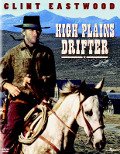
Directed by
Clint Eastwood
105 minutes
Rated MA
Reviewed by
Bernard Hemingway

High Plains Drifter
In his second directorial effort after the successful Play Misty For Me (1971) and his first essay into the Western genre Clint Eastwood’s dourly laconic lead character is straight out of his Sergio Leone films complete with cigar and sticks of dynamite when he rides out of the Californian Sierras and into the little mining town of Lago for a bottle of whiskey and a hot bath. Within minutes he’s shot dead three no accounts and subdued (she didn't mind it really)/raped (at best a misdemeanour, according to local law it seems) the town trollop (Mariana Hill) having barely said a word and done little more than unbutton his duds..
Recalling Richard Wilson’s 1964 classic Invitation To A Gunfighter, High Plains Drifter is the story of how the spineless denizens of a small frontier town hire a gunfighter to protect them against some low lives who are from the story’s righteous perspective only the visible manifestation of a shared moral turpitude. The Stranger, of course, knows this but it his mission to bring down a day of reckoning upon them before resuming his lonely peregrinations.
Economically directed by Eastwood from a script by Ernest Tidyman with uncredited script additions by Dean Reisner, High Plains Drifter is a dark and violent film with a strong vein of gallows humour. It is on the other hand also incongruously shiny, being shot in Technicolor and Panavision by Bruce Surtees on the banks of a serene lake under blue sky, the township clearly having been built for the express purpose of the film. Perhaps the idea here, given the relative brutality of the film particularly for its day, was to emphasize its purely representational nature. It doesn't however really suit the film (unless a certain degree of irreality appeals) and when Eastwood returned to the revenge Western, a sub-genre which is his specialty, in The Outlaw Josey Wales (1976) and, most notably, in Unforgiven (1992) he did not make the same mistake.
Some, myself included, may wonder at the way the pivotal question of The Stranger's identity is handled. The film flashes back to the pivotal scene the death five years earlier by whipping of the town's one time sheriff, Jim Duncan, who, stunt double substitution aside, also appears to be The Stranger. But Duncan is apparently buried in an unmarked grave. And no-one (perhaps bar a midget) in the town recognises The Stranger as him. As with the brand new buildings, the film doesn't try to reconcile the incongurity in what is presumably some kind of meta-level conceptual ploy.
Want something different?





